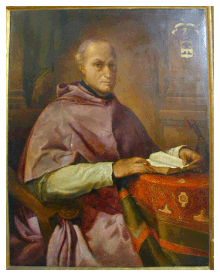|
Paolo Arese
Bishop Paolo Arese C.R. (1574 – 14 June 1644) was a Roman Catholic prelate and scholar who served as Bishop of Tortona (1620–1644).[1][2] On 20 July 1620, he was appointed during the papacy of Pope Paul V as Bishop of Tortona.[1][2] On 20 September 1620, he was consecrated bishop by Giovanni Garzia Mellini, Cardinal-Priest of Santi Quattro Coronati, with Attilio Amalteo, Titular Archbishop of Athenae, and Paolo De Curtis, Bishop Emeritus of Isernia serving as co-consecrators.[2] He served as Bishop of Tortona until his resignation in 1644.[2] He died soon after on 14 June 1644.[2] BiographyPaolo Arese was born in 1574 to the House of Arese. In early youth he entered the Congregation of Clerics Regular of the Divine Providence,[2] and assumed thenceforth the name of Paolo instead of that of Cesare, which he had received in baptism. His precocious learning gained for him, before he had completed his twenty-fourth year, a lectureship in philosophy and theology at Naples; and he afterwards taught theology at Rome, devoting special attention to homiletics. He was not less successful in the practice of sacred eloquence than in teaching its theory. His fame as a preacher spread all over Italy, although he labored under natural impediments which might have altogether stopped the career of anyone less enthusiastic and resolute. In 1620, when he was confessor at Turin to the Princess Isabella of Savoy, he was appointed by Pope Paul V to the bishopric of Tortona. He held that see for twenty-four years, ending with his death in 1644; and during that long period he distinguished himself highly, not only for his activity in the literature of his profession and for his patronage of literary men, but for the earnestness and zeal with which he performed the ordinary duties of his office. Arese and GalileoPaolo Arese was enthused by the celestial discoveries made by Galileo, whom he praised for his astonishing scientific achievements. Being a non-dogmatic Aristotelian philosopher, Arese sought to accommodate any possible disagreements between scientific inquiry and traditional religious ideas. Nonetheless, after the publication of Galileo's Dialogue in 1632, he changed his mind. Both Galileo's indisputable heliocentrism and Urban VIII's early persecution prompted Arese to write a lengthy rebuttal of the Copernicanism, which he interpolated into the last volume of his own most renown book, Le imprese sacre. WorksPaolo Arese was a voluminous writer, both in Latin and in Italian, and left a large number of manuscripts unpublished. The following are his published Latin works:
His works in Italian are greatly more voluminous; and of those in the following list there is hardly any, which did not pass through several editions in the course of the seventeenth century. An enumeration of editions, with fuller details as to the contents of each work, will be found in Mazzucchelli:
References
External links and additional sources
|
||||||||||||||||||||||||||
